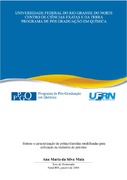Please use this identifier to cite or link to this item:
https://repositorio.ufrn.br/handle/123456789/17681| Title: | Síntese e caracterização de poliacrilamidas modificadas para utilização na indústria do petróleo |
| Other Titles: | Sinthesis and characterization of modified polyacrylamides for aplication in petroleum industry |
| Authors: | Maia, Ana Maria da Silva |
| Advisor: | Balaban, Rosângela de Carvalho |
| Keywords: | Poliacrilamida;Reologia;Espalhamento de luz;Polyacrylamide;Rheology;Light scattering |
| Issue Date: | 25-Jan-2008 |
| Publisher: | Universidade Federal do Rio Grande do Norte |
| Citation: | MAIA, Ana Maria da Silva. Sinthesis and characterization of modified polyacrylamides for aplication in petroleum industry. 2008. 26 f. Tese (Doutorado em Físico-Química; Química) - Universidade Federal do Rio Grande do Norte, Natal, 2008. |
| Portuguese Abstract: | Poliacrilamidas modificadas com ≅ 0,2 mol % de N,N-dihexilacrilamida e grau de hidrólise de 0 a 25 % foram sintetizadas por copolimerização micelar. O monômero hidrofóbico foi obtido pela reação entre cloreto de acriloíla e N,N-dihexilamina e foi caracterizado por espectroscopia no infravermelho (IV) e ressonância magnética nuclear de próton (1H RMN). As estruturas moleculares dos polímeros foram determinadas através de espectroscopia de RMN 1H e 13C e os polímeros foram estudados em regime diluído e semidiluído por viscosimetria, reometria, espalhamento de luz estático e espectroscopia de correlação de fótons, na faixa de temperatura de 25 a 55 ºC. Os dados obtidos por viscosimetria mostraram que as viscosidades intrínsecas dos polímeros hidrolisados são maiores que a do polímero precursor na mesma força iônica e a comparação entre os polímeros carregados mostrou que o polímero com maior grau de hidrólise tem uma estrutura mais compacta em água de formação sintética (AFS). A elevação da temperatura induziu um aumento na viscosidade reduzida dos polímeros em água Milli-Q (AMQ). Em solução salina, apenas o polímero neutro apresentou aumento na viscosidade reduzida com a temperatura, enquanto os derivados hidrolisados apresentaram uma diminuição na viscosidade reduzida. A partir do espalhamento de luz estático (SLS), em meio salino, foi evidenciada uma diminuição da massa molar ponderal média (⎯Mw) com o aumento do grau de hidrólise, que foi atribuída à redução das interações termodinâmicas entre polímero e solvente, o que pôde ser deduzido pela diminuição do segundo coeficiente do virial (A2). Os polímeros apresentaram mais de um modo de relaxação em solução, quando analisados por espectroscopia de correlação de fótons, e esses modos foram atribuídos a cadeias isoladas e a agregados de diversos tamanhos. O comportamento de agregação dependeu fortemente da força iônica, e também da temperatura, embora de uma forma menos pronunciada. Os polímeros apresentaram grandes agregados em todas as condições estudadas, contudo, suas soluções não mostraram um bom aumento na viscosidade da água para serem usados em processos de recuperação melhorada de petróleo (EOR) |
| Abstract: | Modified polyacrylamides with ≅ 0.2 mol % of N,N-dihexylacrylamide and hydrolysis degree from 0 to 25 % were synthesized by micellar copolymerization. The hydrophobic monomer was obtained by the reaction between acryloyl chloride and N,Ndihexylamine and characterized by infrared (IR) and proton nuclear magnetic resonance (1H NMR) spectroscopy. The polymer molecular structures were determined through 1H and 13C NMR spectroscopy and the polymers were studied in dilute and semi-dilute regimes by viscometry, rheometry, static light scattering and photon correlation spectroscopy, at the temperature range from 25 to 55 ºC. The data obtained by viscometry showed that the intrinsic viscosity from the hydrolyzed polymers is larger than the precursor polymers at the same ionic strength. The comparison between the charged polymers showed that the polymer with higher hydrolysis degree has a more compact structure in formation water (AFS). The increase of temperature led to an enhanced reduced viscosity to the polymers in Milli-Q water (AMQ), although, in brine, only the unhydrolyzed polymer had an increase in the reduced viscosity with the temperature, and the hydrolyzed derivatives had a decrease in the reduced viscosity. The static light scattering (SLS) analyses in salt solutions evidenced a decrease of weight-average molecular weight (⎯Mw) with the increase of the hydrolysis degree, due to the reduction of the thermodynamic interactions between polymer and solvent, which was evidenced by the decrease of the second virial coefficient (A2). The polymers showed more than one relaxation mode in solution, when analyzed by photon correlation spectroscopy, and these modes were attributed to isolated coils and aggregates of several sizes. The aggregation behavior depended strongly on the ionic strength, and also on the temperature, although in a lower extension. The polymers showed large aggregates in all studied conditions, however, their solutions did not displayed a good increase in water viscosity to be used in enhanced oil recovery (EOR) processes |
| URI: | https://repositorio.ufrn.br/jspui/handle/123456789/17681 |
| Appears in Collections: | PPGQ - Doutorado em Química |
Files in This Item:
| File | Description | Size | Format | |
|---|---|---|---|---|
| AnaMariaSM.pdf | 212,85 kB | Adobe PDF |  View/Open |
Items in DSpace are protected by copyright, with all rights reserved, unless otherwise indicated.

